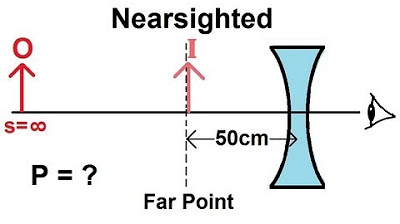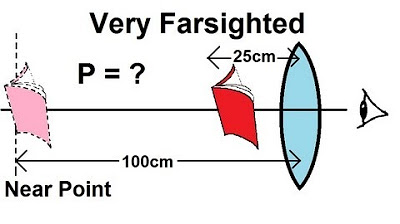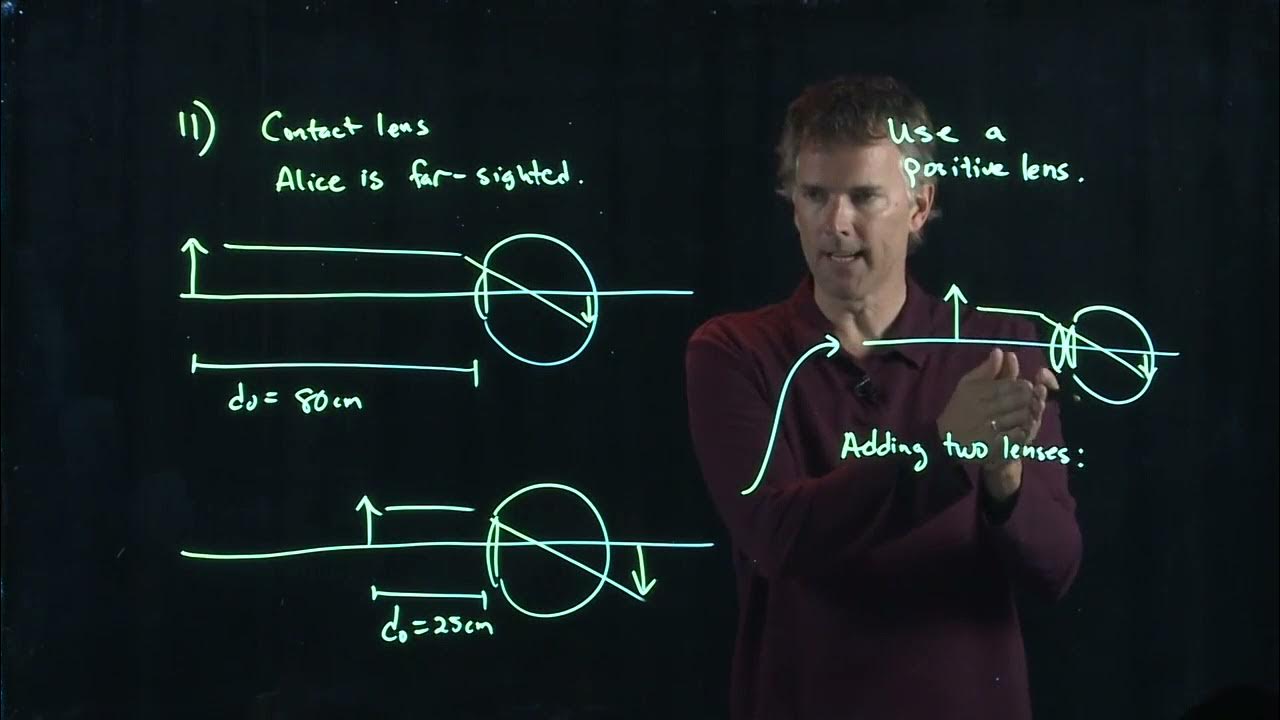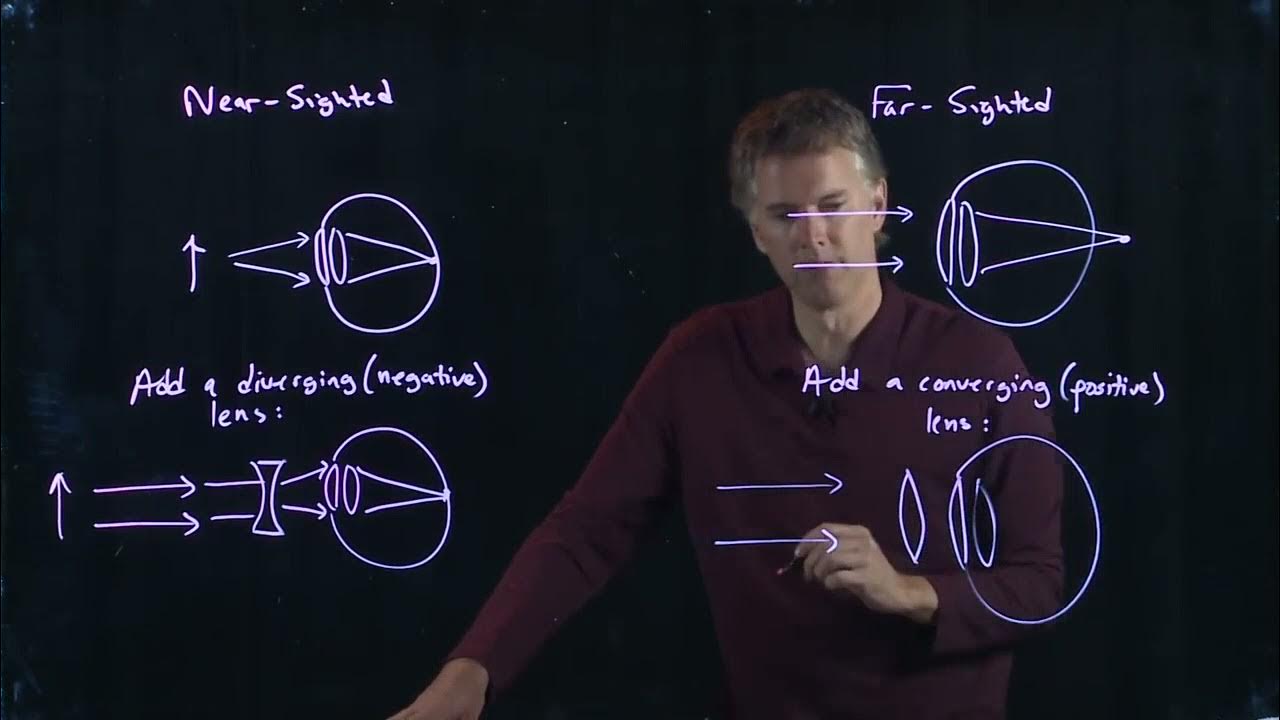Physics - Optics: Vision Correction (4 of 5) Farsighted
TLDRThis online lecture explains the concept of farsightedness, where individuals can see distant objects clearly but struggle with close-up vision. To correct this, one needs converging lenses to form an image at the near point, which is the closest distance at which objects can be seen clearly. The lens equation is used to determine the required focal length, and the power of the lens is calculated in diopters. The example provided demonstrates how to calculate the necessary lens power for a farsighted person with a near point beyond arm's reach, emphasizing the importance of corrective vision for clear sight.
Takeaways
- 👓 Farsightedness is a condition where distant objects are seen clearly, but close objects appear blurry.
- 📚 The typical comfortable reading distance is about 25 centimeters or 10 inches for most people.
- 🔍 Farsighted individuals struggle to see clearly at this close distance, making reading difficult.
- 🌌 When a book is moved farther away, a farsighted person can focus on it, but the small size of the text becomes an issue.
- 👓 Corrective vision with converging lenses is necessary for farsighted individuals to see objects clearly at close range.
- 🔧 The lens equation \( \frac{1}{F} = \frac{1}{s} + \frac{1}{s'} \) is used to calculate the required lens power for near vision correction.
- 📏 The near point is the closest distance at which a person can see objects clearly without corrective lenses.
- 📐 For a farsighted person, the near point is beyond the typical reading distance, requiring lenses to converge the light before reaching the eye.
- 🔢 The power of the lens is calculated as the reciprocal of the focal length in meters, with positive values indicating converging lenses.
- 👀 A lens with a focal length of 50 centimeters, or a power of +2 diopters, is an example of what a farsighted person might need for clear near vision.
- 🛒 Reading glasses with the correct power, indicated in diopters, can help correct farsightedness for close-up tasks.
Q & A
What does being farsighted mean?
-Being farsighted means that you can see distant objects clearly, but have difficulty seeing objects that are close up, such as when trying to read a book.
What is the typical comfortable reading distance for most people?
-The typical comfortable reading distance is assumed to be about 25 centimeters or 10 inches away.
Why do farsighted individuals struggle to read a book at a comfortable distance?
-Farsighted individuals struggle because the letters appear as a sea of characters, making it impossible to distinguish them clearly at close range.
What is the lens equation used to find the near point for a farsighted person?
-The lens equation used is 1/F = 1/s + 1/s', where F is the focal length, s is the object distance, and s' is the image distance.
What is the significance of the 'near point' for a farsighted person?
-The 'near point' is the nearest distance at which a farsighted person can see objects clearly without corrective lenses.
How can corrective lenses help a farsighted person see clearly at the near point?
-Corrective lenses, specifically converging lenses, help form an image at the near point, allowing the farsighted person to see objects clearly at that distance.
What is the focal length of a lens needed for a farsighted person with a near point of 50 centimeters?
-A converging lens with a focal length of 50 centimeters is needed to form an image at the near point of 50 centimeters.
How is the power of a lens calculated and what are its units?
-The power of a lens is calculated as the reciprocal of the focal length in meters, and its units are diopters.
What is the power of the lens needed for a farsighted person with a near point of 50 centimeters?
-The power needed is 2 diopters, as the focal length is 0.5 meters (50 centimeters).
Why is a positive power indicated by 'plus' and what does it mean for a lens?
-A positive power indicated by 'plus' means that the lens is a converging lens, which brings light rays together to form an image.
What should a farsighted person look for in reading glasses to correct their vision?
-A farsighted person should look for reading glasses with a power of +2 diopters to correct their vision at the near point.
Outlines
👓 Understanding Farsightedness and Corrective Lenses
This paragraph explains the concept of farsightedness, where individuals can see distant objects clearly but struggle with close-up vision. It describes the typical issue of reading a book at a standard distance of 25 centimeters and how farsighted individuals would have difficulty focusing on the text at this distance. The paragraph then introduces the lens equation as a method to determine the necessary corrective lens power for someone with farsightedness. It provides a step-by-step explanation of how to use the lens equation to find the focal length and power of the lens needed to correct vision, using an example where the near point is 50 centimeters away. The summary concludes with the calculation of the lens power in diopters, which is the unit used to measure the strength of corrective lenses.
Mindmap
Keywords
💡Farsighted
💡Near Point
💡Corrective Vision
💡Converging Lenses
💡Lens Equation
💡Focal Length
💡Power of the Lens
💡Diopters
💡Virtual Image
💡Reading Glasses
Highlights
Farsightedness is the ability to see distant objects clearly but difficulty seeing things up close.
Farsighted individuals struggle to see clearly at a typical reading distance of 25 centimeters.
Corrective lenses are needed to form an image at the near point for farsighted individuals.
The lens equation 1/F = 1/s + 1/s' is used to calculate the required lens power.
A near point is the closest distance at which a farsighted person can see clearly.
Focal length of the corrective lens is calculated using the lens equation with object distance and near point.
A virtual image is formed in front of the lens for farsightedness correction.
The power of the lens is the reciprocal of the focal length in meters.
Positive lens power indicates a converging lens, suitable for farsightedness.
Diopters are the unit used for measuring lens power.
A lens power of +2 diopters can correct vision for a farsighted person with a near point of 50 cm.
Farsighted individuals with a more distant near point require stronger corrective lenses.
Prescription reading glasses with the appropriate power can correct farsightedness.
Understanding the near point and using the lens equation is crucial for vision correction.
Transcripts
Browse More Related Video

Physics - Optics: Vision Correction (2 of 5) Nearsighted

Physics - Optics: Vision Correction (5 of 5) Very Farsighted

Physics - Optics: Vision Correction (1 of 5) Introduction

Contact Lenses | Physics with Professor Matt Anderson | M28-21

Near Sighted vs Far Sighted | Physics with Professor Matt Anderson | M28-02

Near Point and Far Point | Physics with Professor Matt Anderson | M28-06
5.0 / 5 (0 votes)
Thanks for rating: